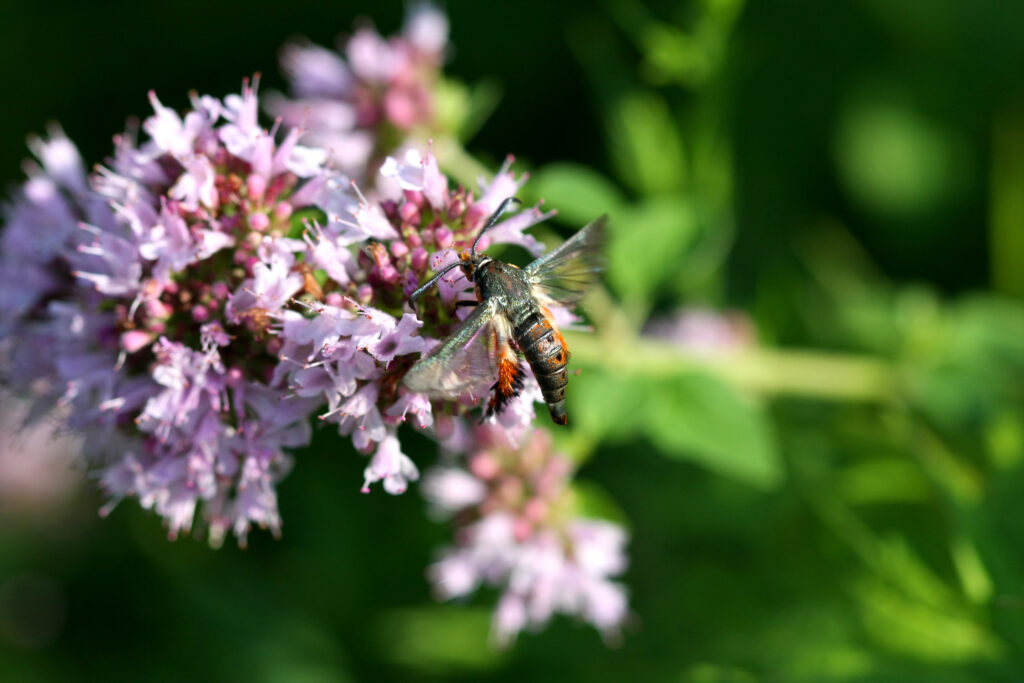The squash vine borer is a wrinkled, cream-colored caterpillar with a brown head, about 1 to 2 inches long.
The adult form of the vine borer is a narrow-winged olive-brown moth with a 1- to 1½-inch wide wingspan. The moth has fringed hind legs, a red abdomen with black rings, and translucent wings. It is sometimes mistaken for a small wasp.
Good Products for Pest and Disease Control at Amazon:
- Garden Safe Snail and Slug Bait
- Bonide Sulfur Fungicide
- Monterey BT Caterpillar Killer
- Neem Bliss 100-% Cold Pressed Neem Oil
- Safer Brand Insect Killing Soap
- PyGanic Botanical Insecticide

The larvae squash vine borer tunnels into the vining stems of squash and pumpkin plants and eats the vascular tissue causing vines to collapse and fail.
Adult moths emerge in early summer and lay reddish-brown eggs near the base of squash plants and on the undersides of leaves. When the eggs hatch, the larvae immediately chew their way inside vines and then feed for up to six weeks. The feeding disrupts plant vascular tissue which delivers water and nutrients to the stems and leaves from roots. This injury commonly causes the vine to collapse, rot, and die from the point of injury.
Moths lay eggs over a period of about two months so the threat to plants is ongoing through the summer. Larvae and pupae overwinter in the soil and emerge as adults the following year when the weather warms.
There are two generations of squash vine borers each year in warm-summer regions and one generation in cool-summer regions.
Squash vine borers are found throughout the United States and Canada.
Scientific name: Melittia cucurbitae

Target plants
Squash vine borers attack summer squashes, zucchini, pumpkins, Hubbard squashes, and some winter squashes.
Feeding habits and damage
Squash vine borers bore into the stems of squash-family plants and eat vascular tissue. Borers create small entry holes in stems; at the entry point, there will be a small pile of moist, sawdust-like debris, called frass. Feeding borers cause vines to suddenly wilt and collapse; vines then rot and death commonly follows.
Organic controls
Early in the season exclude moths from laying eggs by covering plants with spun poly floating row covers. Spray the base of plants with pyrethrin repeatedly to kill young larvae before they enter vines.
Organic control calendar
Here is what you can do seasonally to control squash vine borers:
- Before planting: Early in the growing season, cover the seedbed or seedling with spun poly floating row covers (uncover later for pollinators or hand-pollinate female flowers). Set a yellow pan filled with water near squash vines; the adult moths will be attracted to the yellow, land in the water, and drown.
- At planting time: Plant summer squashes later than usual to avoid early-season infestations. Stagger plantings to avoid compromising the entire crop; plant a new mound of squash every few weeks. Cover seedbeds and young transplants with spun poly row cover to prevent moths from laying eggs; remove covers when vines start to flower or hand pollinate. Fertilize vines to encourage fast growth; plants may produce fruits before borer damage can slow or stop vine growth. Encourage secondary rooting along healthy vines; mound soil over leaf nodes every four or five feet along the length of the vine; when a section of the vine is attacked by a borer, other sections supported by secondary roots will not collapse.
- While crops develop: Crush egg clusters at the base of plants or on the undersides of leaves. Spray the base of plants with pyrethrin repeatedly to kill young larvae before they enter vines. Search for larvae entry holes—about 3 feet from the base of the plant; slit the vine near the hole with a sharp knife near the hole, pull back the tissue to remove the borer and crush it; close the tissue and mound an inch or two of moist soil over the cut to encourage healing and secondary root formation. Alternatively, inject Bacillus thuringiensis into the stem with a hypodermic needle; when borers feed on tissue infused with Bt they will die. Or use a flashlight at night to illuminate the silhouette of borers inside the vines then stick a straight pin through the vine to impale the borer; repeat every three days until all borers have been discovered and killed.
- After harvest: Shred infected vines to expose any larvae to cold or predators or hand collection and crushing.
Natural predators
Songbirds will eat squash vine borer moths.
Squash articles at Harvest to Table:
How to Grow Summer and Winter Squash
How to Plant and Grow Pumpkins
How to Harvest and Store Summer Squash
How to Harvest, Cure, and Store Winter Squash
How to Harvest and Store Pumpkins
Eight Ways to Cook and Serve Summer Squash
Seven Ways to Cook and Serve Winter Squash
How to Make Creamy Pumpkin Soup
How to Cook and Serve Squash Blossoms
Squash Growing Problems: Troubleshooting
Squash Vine Borer Organic Pest Control
Squash Bug Organic Pest Control
Corn, Beans, and Squash: The Three Sisters
Related articles:
Vegetable Garden Organic Pest Control
Vegetable Garden Diseases Problem Solver
Vegetable Garden Organic Weed Control
Garden Planning Books at Amazon:
- Vegetable Garden Almanac & Planner
- Kitchen Garden Grower’s Guide Vegetable Encyclopedia
- Vegetable Garden Grower’s Guide
- Tomato Grower’s Answer Book















